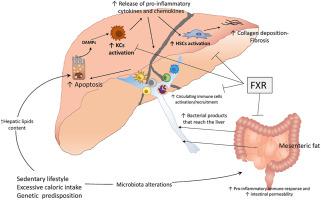Molecular and Cellular Endocrinology ( IF 3.8 ) Pub Date : 2022-04-25 , DOI: 10.1016/j.mce.2022.111650 Stefano Fiorucci 1 , Angela Zampella 2 , Patrizia Ricci 1 , Eleonora Distrutti 3 , Michele Biagioli 1

|
The Farnesoid-x-receptor (FXR) is a bile acids sensor activated in humans by primary bile acids. FXR is mostly expressed in liver, intestine and adrenal glands but also by cells of innate immunity, including macrophages, liver resident macrophages, the Kupffer cells, natural killer cells and dendritic cells. In normal physiology and clinical disorders, cells of innate immunity mediate communications between liver, intestine and adipose tissues. In addition to FXR, the G protein coupled receptor (GPBAR1), that is mainly activated by secondary bile acids, whose expression largely overlaps FXR, modulates chemical communications from the intestinal microbiota and the host's immune system, integrating epithelial cells and immune cells in the entero-hepatic system, providing a mechanism for development of a tolerogenic state toward the intestinal microbiota. Disruption of FXR results in generalized inflammation and disrupted bile acids metabolism. While FXR agonism in preclinical models provides counter-regulatory signals that attenuate inflammation-driven immune dysfunction in a variety of liver and intestinal disease models, the clinical relevance of these mechanisms in the setting of FXR-related disorders remain poorly defined.
中文翻译:

FXR 的免疫调节功能
Farnesoid-x-受体 (FXR) 是一种在人体中被初级胆汁酸激活的胆汁酸传感器。FXR 主要在肝脏、肠道和肾上腺中表达,但也由先天免疫细胞表达,包括巨噬细胞、肝脏驻留巨噬细胞、枯否细胞、自然杀伤细胞和树突状细胞。在正常生理和临床疾病中,先天免疫细胞介导肝脏、肠道和脂肪组织之间的通讯。除 FXR 外,主要由次级胆汁酸激活的 G 蛋白偶联受体 (GPBAR1),其表达在很大程度上与 FXR 重叠,调节肠道微生物群和宿主免疫系统的化学通讯,整合上皮细胞和免疫细胞肠肝系统,为肠道微生物群产生耐受性状态提供了一种机制。FXR 的中断导致全身炎症和胆汁酸代谢中断。虽然临床前模型中的 FXR 激动剂提供了可减轻各种肝脏和肠道疾病模型中炎症驱动的免疫功能障碍的反调节信号,但这些机制在 FXR 相关疾病中的临床相关性仍然不明确。


















































 京公网安备 11010802027423号
京公网安备 11010802027423号